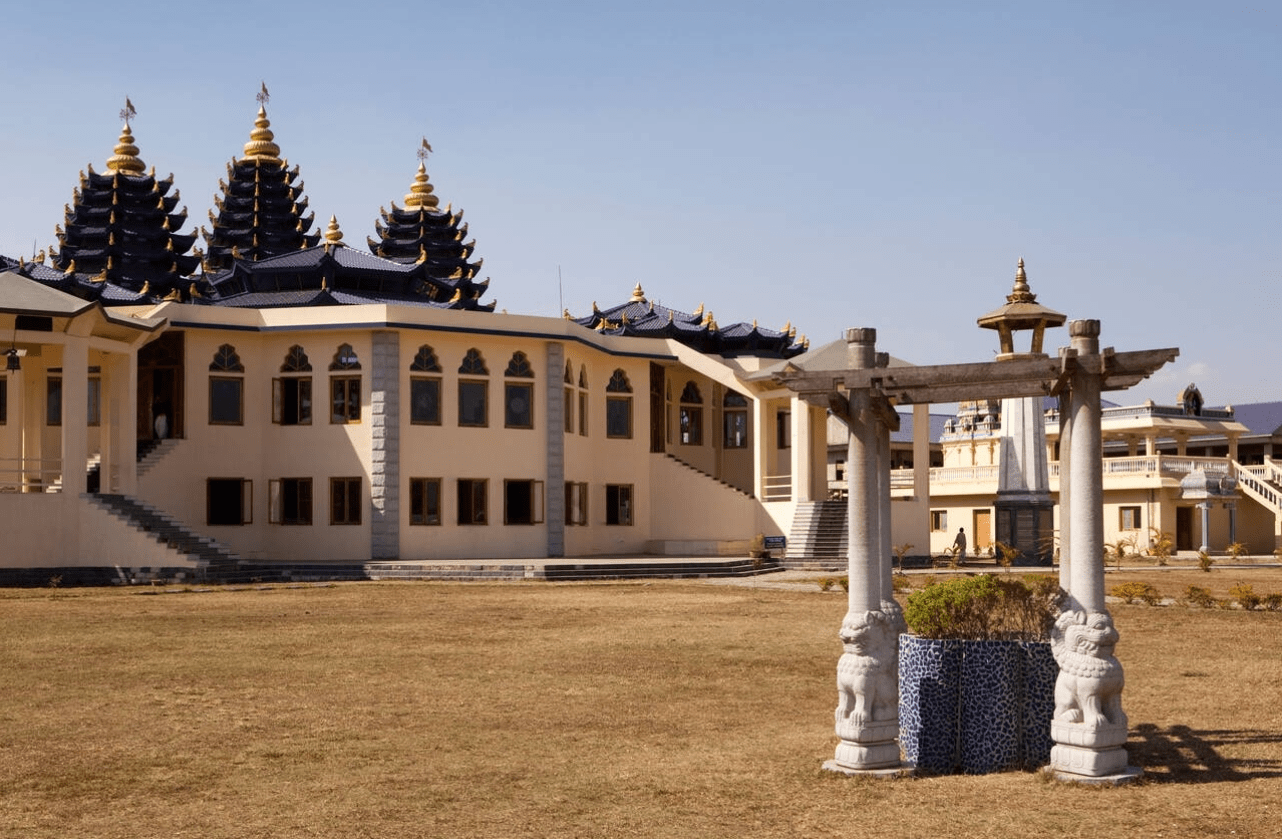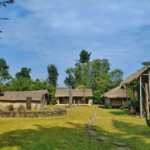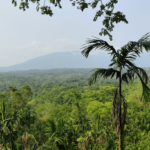Places to Visit in Imphal: Manipur had long been on our travel radar. We had first set foot in this enchanting Indian state, aptly named the Jewel of India, a few years ago when we traveled to Myanmar. At that time, our visit to Imphal was brief—we only stayed long enough to drive to Moreh and cross the Moreh-Tamu border into Myanmar. What an adventure that was! But this blog isn’t about my past travels; it’s about Imphal, the capital of Manipur. On our second visit, we spent a few days in Imphal, delving into the city’s offerings as much as we could.
Govindajee Temple – Places to Visit in Imphal
Imphal boasts a wealth of attractions, and spending at least two days here is highly recommended. However, if you’re pressed for time and only have one day, start your exploration early. Key attractions include Kangla Fort, Ema Keithel, Govindajee Temple, the Imphal Second World War Cemetery, and the Polo Ground. This comprehensive Imphal Travel Guide will provide you with details on the best places to visit, where to eat, and other essential information.
Before diving into the sights of Imphal, let’s take a moment to understand the city itself.
Imphal – The Capital of Manipur
Imphal is the capital city of Manipur, a picturesque state in northeastern India. Naturally, it is the most developed city in the state and serves as its commercial hub. Nestled amid hilly landscapes, Imphal features stunning natural beauty.
One of the oldest cities in the region, Imphal has a rich historical background that spans over 2,000 years. The fertile land surrounded by hills has attracted various political powers over the centuries. Both Burma and the British sought control of this strategic location. Modern Imphal has been shaped by significant historical events, including the Burmese invasion of Manipur in 1819, British colonization, and the impact of World War II.
The city is divided into East Imphal and West Imphal, with Kangla Fort at its core, both literally and figuratively. The Imphal River flows through the Fort complex, splitting it into two sections and forming an integral part of Imphal’s heritage. I won’t delve deeply into Imphal’s history here but plan to cover it in a separate blog.
Kangla-sha at Kangla Fort – Places to Visit in Imphal
Meitei is the predominant language spoken in the state, with English also commonly used. Hindi is less prevalent. Historically, the Meitei language used Bengali script, but recent efforts are reviving the traditional Meitei script.
Imphal and Manipur have long been part of a fascinating civilization that is not widely known. Its remote location adds to the intrigue.
Places to Visit in Imphal
The charm of Imphal lies in its compact layout, with many attractions located near the city center. Exploring these sites on foot is an excellent way to immerse yourself in Manipur’s history and culture. Alternatively, you can hire a local auto rickshaw for convenience.
We spent two days in Imphal, visiting the following places in the order listed. You can follow this itinerary or create your own.
- Kangla Fort
Kangla Fort is located in the heart of Imphal and is essentially the city’s epicenter. It was our first stop during our visit.
Kangla Fort, Imphal in Manipur
History of Kangla Fort
According to Meitei texts known as the Puyas, Manipur’s history dates back to around 1500 BC, with Kangla Fort playing a crucial role. It has always been a significant seat of power, evident from the various structures within the fort complex.
Kangla Fort evolved over time, with major construction occurring during the reign of King Khagemba (1597–1652 AD) and further enhancements by his son Khunjaoba (1632–1666 AD). The fort endured significant damage during the Burmese invasion of 1819, the Anglo-Manipuri War in 1891, and the period following Indian independence when it was under the control of the Assam Rifles. It was only recently returned to the people of Manipur and now stands as a prominent attraction in Imphal.
Inside the Kangla Fort
Kangla Fort is expansive, with multiple gates, but entry is only through the main gate. After purchasing tickets, we entered the complex and were immediately struck by the lush greenery and tranquility. A guide, bicycles, or a buggy are available for hire at the entrance, although walking is also an option. Given the fort’s size, a buggy might be preferable for a comprehensive tour.
The fort’s large grounds are surrounded by two concentric moats (Thangapat), lined with trees and pathways. Riding a buggy through the shaded paths was delightful, and cycling would offer a similar experience.
Inside the Kangla Complex, we encountered several old temples, graves, colonial-style cottages, rebuilt structures, and gardens. Our first stop was the Kangla-sha structures.
Kangla-sha
The Kangla-sha are mythical dragon-like structures in front of the main Kangla Fort. Although the original fort was demolished long ago, these guardian figures, resembling horses, have been reconstructed and renovated.
During our visit, preparations for a Republic Day event were underway, which led to the fort being closed to visitors. We managed to view the Kangla-sha up close, but photographic opportunities were limited.
Old Govindajee Temple
Our next stop within the complex was the Old Govindajee Temple, a former place of worship for Lord Krishna, showcasing exquisite architecture.
Ibudhou Pakhangba Temple
Another highlight inside the complex is the Ibudhou Pakhangba Temple, notable for its unique white architecture.
Hijagang
We also explored Hijagang, a glass house displaying long Manipuri boats used in local boat races. These boats, with dragon faces, are reminiscent of Viking vessels.
Museums and Colonial Structures
The Kangla Fort complex includes several colonial structures and a museum showcasing Manipur’s history. The fort’s vastness means it deserves a dedicated blog, but this overview gives a glimpse of its offerings.
Opening Time: 9 AM to 5 PM
Time Required: Minimum 2 hours
- Shahid Minar
Next, we visited Shahid Minar, located a short walk from the Fort Complex. This white tower, situated in Bir Tikendrajit Park, honors the Meiteis and local soldiers who died bravely in the Anglo-Manipuri War of 1891. The Minar features three vertical beams adorned with carvings of mythological dragons.
Mythological Dragons on Shahid Minar
The park commemorates Prince Bir Tikendrajit and General Thangal, who were executed by the British in 1891.
- Imphal Polo Ground
Located a few minutes from the main market area, Imphal Polo Ground is significant to the history of polo. Known locally as Sagol Kangei, it is believed that modern polo originated here. The outer polo ground, Mapal Kangjeibung, is still used for polo matches.
Imphal Polo Ground
Another polo ground within Kangla Fort, Manung Kangjeibung, is reputedly the world’s oldest, dating back to the 15th century BC. During our visit, we saw the impressive outer polo ground, though it was empty at the time. We missed a recent tournament but hope to catch a match on our next visit.
- Ima Keithel or Mother’s Market
Our next destination was Ima Keithel, also known as Mother’s Market. Located near the Shahid Minar, this extensive market is run exclusively by women and is one of Asia’s largest women-only markets.
Deities Inside Ima Keithel
With approximately 5,000 women vendors, Ima Keithel offers a diverse range of goods from handlooms and handicrafts to vegetables, fruits, and meat. The market is a sensory delight, featuring Manipuri dolls, traditional clothing, and various local crafts.
Opening Time: Monday to Sunday from 4 AM to 7 PM
Time Required: Minimum 1 hour
Nearby, you can find the Nupi Lan Memorial, commemorating women’s resistance against British soldiers, and a statue of King Bhagyachandra taming an elephant, reflecting Manipur’s rich history.
- Imphal War Cemetery
Northeast India, particularly Manipur and Nagaland, witnessed significant World War II battles. The Imphal War Cemetery is dedicated to the soldiers who fought in these intense battles, including the pivotal Battle of Imphal.
Commonwealth War Cemetery or Imphal War Cemetery
The Imphal War Cemetery contains around 1,600 graves of European and US soldiers. Nearby is the Imphal Indian Army War Cemetery, which honors Indian soldiers with about 828 graves, including a cremation memorial for Hindu and Sikh soldiers.
- Shree Govindajee Temple
Shree Govindajee Temple, close to the Manipur Palace, is the largest Vaishnava temple in Imphal, dedicated to Lord Krishna. We visited early in the morning to witness the serene Aarti (prayers).
Golden Dome at Govindajee Temple
The temple’s pristine white facade and golden dome create a tranquil atmosphere. Inside, the main chambers house images of Lord Krishna, Radha, and other deities. We observed the morning Aarti, complete with traditional rituals and hymns.
- RKCS Art Gallery
RKCS Art Gallery, located on Keishamthong RKCS Colony, is a must-visit for art enthusiasts. Dedicated to the renowned Manipuri artist Rajkumar Chandrajit Sana, the gallery showcases his paintings and artifacts.
**RKCS Art Gallery – Places to Visit in
Imphal**
Opening Time: 9 AM to 4 PM
Time Required: Minimum 1 hour
- Keibul Lamjao National Park
While not within Imphal city, Keibul Lamjao National Park, located in the southeastern part of the state, is a significant attraction. It is home to the endangered Sangai deer and offers unique boating experiences.
Keibul Lamjao National Park
We had limited time and didn’t visit the park, but it is worth a day trip if you have the chance.
Conclusion
Our time in Imphal was short but enriching. From exploring historical forts and temples to experiencing local markets and museums, Imphal offers a glimpse into Manipur’s vibrant culture and history. Whether you have a day or more to explore, Imphal is a destination that promises memorable experiences.


